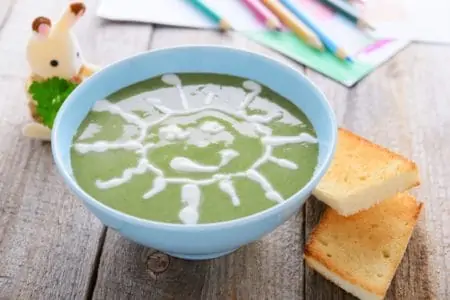Every parent has been there: the endless battle of getting toddlers to eat their greens. Health authorities recommend consuming at least 5 fruits and vegetables daily (1), and we as caregivers must find effective ways to incorporate them.
So how can you ensure your toddler gets the benefits of veggies without the fuss?
We’ve poured hours into research and come up with the tried-and-true methods to answer the burning question of how to get toddlers to eat vegetables. Trust us, with the right approach, you and your toddler can enjoy mealtime again. Plus, we share 10 veggie-packed recipes to test your new methods.
Key Takeaways
- Toddlers often dislike vegetables due to taste preferences and influences from food advertisements.
- Sneak vegetables into meals by using purees, adding them to meat dishes, or making fun recipes like “Green Eggs and Ham.”
- Make vegetables more appealing by using sweet recipes, making substitutions, or creating toddler-friendly juices and smoothies.
- Encourage vegetable consumption through fun activities, including toddlers in meal preparation and leading by example.
Why Don’t Toddlers Like Vegetables?
Understanding why toddlers, and even some older children, resist vegetables can shed light on strategies to make greens more appealing. As infants between 4 and 6 months are introduced to food, it’s typically without the addition of sugars and salts. However, as they transition to table foods, their palate expands, often influenced by the meals their families consume.
It’s easy to think it might be your fault, but that’s not necessarily true. There is convincing evidence that the sugar, salt, and fat found in packaged toddler foods create a preference for these foods instead of vegetables. It is, therefore, important to check nutrition labels before giving them to your child.
Furthermore, the universal nature of food advertising, especially those promoting non-vegetable “kid-friendly” foods, makes vegetables seem less enticing on a plate (2).
Here are some strategies to expand your toddler’s palate beyond what I call “the kid trifecta”: macaroni and cheese, pizza, and chicken nuggets.
How to Get a Toddler to Eat Vegetables
1. Sneaky Vegetables
Hiding the vegetables may be sneaky, but it’s smart. Purees are fantastic for this since you can add them in without making it too obvious.
- Colors: Be careful with the colors. Blend white or orange vegetables, such as yellow squash or cauliflower, into dishes like mac and cheese for a cheesy appearance and creamy texture.
- Meat dishes: If you’re cooking with meat, such as lasagna or meatballs, use shredded carrots, beets, or zucchini. Not only does this up the intake of vegetables, but it makes the dish tasty as well. With soups, try to juice up the greens and add accordingly. Many toddlers don’t like to see the vegetables, so pureeing them in soups may be more agreeable to them.
- Fun: You could also make it fun by recreating Dr. Seuss’ “Green Eggs and Ham.” Puree some broccoli and scramble it into the eggs.
I recommend this technique to many of my parents. Tomato sauce, for example, is a great way to hide cooked veggies. Just add them to a blender with your sauce of choice, then heat it. This sauce can be used on pasta for toddlers who are willing to eat “red” sauce or as a pizza sauce added to prepared pizza dough. Either way, your child will get a few portions of vegetables.
Editor's Note:
Dr. Leah Alexander, MD, FAAP2. Make It Sweet
Vegetable-laden sweet treats are a hit. For instance, zucchini in chocolate cake is surprisingly delicious and, better yet, so subtle that your toddler won’t notice it.
- Cookies: For healthier cookie dough, replace some butter with white-bean puree or bananas; for brownies, consider adding pureed spinach.
- Cakes and pancakes: Add beets to chocolate cakes or carrots or squash to yellow cakes when baking cakes. During the fall, experiment with pumpkin pancakes. It’s important to match the colors, though — remember, all light vegetables go with light-colored cakes.
3. Substitutions
If you can’t sneak the veggies in, simply switch the whole thing up.
- Veggie burgers: These are great substitutes instead of regular meat patties and work wonders. You can disguise them with some cheese and other vegetables your toddler is used to eating with their burgers. Just be sure to research which veggie burgers are certified and hexane-free. Hexane is used in the processing of some soy-based versions and is a neurotoxin (3).
- Spaghetti squash: This is a godsend for picky eaters. It looks, and pretty much tastes, like real spaghetti. Cover it up with some sauce and cheese — your toddler will never notice the difference.
- Tacos: Tacos are another excellent way to substitute meat. Instead of beef, use veggie crumbles. Disguise it under sour cream or shredded cheese.
4. Juice It
A simple way to make vegetables more appealing is by creating a toddler-friendly juice or cocktail. If your little one doesn’t mind, you can easily serve it as it is. You could also make it into a smoothie by adding yogurt, nut butter, or milk. Smoothies have the added benefit of keeping the fiber of the fruit or vegetables while making the flavor more toddler-friendly.
- Ice pops: With vegetable juice, you can create fun ice pops. Everything is more fun when in the shape of an icy treat.
- Fruit: Adding a little fruit won’t hurt — it will only give some sweetness to it. Bananas, spinach, grapes, honey, and some Greek yogurt make for a nutritious blend.
There are many prepared blended juices and smoothies available on the market, something very convenient for busy parents. However, some contain added sugar, so it is important to check the nutrition label.
Also, I have some parents who use bottled fruit juice to make veggie smoothies for their children. Unfortunately, such juices contain lots of sugar, this making the smoothie unhealthy (4). I recommend using coconut water instead which also gives added potassium.
Editor's Note:
Dr. Leah Alexander, MD, FAAPBaby Under 12 Months?
5. Make It Fun
Instead of using force, try fun. Toddlers love it when you make a situation fun, and a great way to do this is by creating a game (6).
Sit down with your toddler and help each other divide the vegetables into color-coded categories. Then, you can ask them which color you should eat today. The one they choose must be one of the foods on both of your plates.
You could also ask them which color to add to a pizza or tacos. By doing this, you’re giving them a sense of achievement as they help with dinner, and the involvement can create a positive association with food.
6. Include Them in the Process
Our little one despised vegetables until he began helping out in the kitchen. Including him in the process was the tip that worked wonders. By letting him do his small experiments, he would end up eating them as well.
It’s best to start by creating a safe space — all sharp knives off the counter. You can easily find kid-friendly kitchen tools online. Then, choose a small selection of vegetables for them to focus on — pick items that go well together.
Let them immerse themselves in the process. Ask them to choose a method of cooking, but keep them away from the stove. While the veggies are cooking, have your toddler prepare something else.
Once finished, let your helper sprinkle on a topping, like Italian seasoning or a little cheese. You’ll be amazed to see how excited your toddler will be to dig in.
Some of my patients love a particular condiment or seasoning. Ketchup seems to be a favorite. My recommendation to parents is that if their child will eat the vegetables when ketchup is added, then go ahead and use it.
Editor's Note:
Dr. Leah Alexander, MD, FAAP7. Teach Them About Produce
For older toddlers, turn mealtime into a learning experience. Spark their curiosity about how to select fresh tomatoes or the reasons behind peeling a potato. Incorporate these lessons during grocery shopping excursions. Discuss where vegetables originate, like if they sprout above or beneath the soil.
Share the health benefits of different colored vegetables—such as how red veggies benefit our hearts and eyes (7). Encourage them to taste before forming opinions. To elevate their enthusiasm, think about starting a small vegetable garden together.
8. Try Dips
A tasty hummus dip is always included on our dinner table, and our kids have always loved it. Including dips allows your toddler to interact with the food — it makes eating so much more fun.
Rotate between hummus, guacamole, fruity salsas, ranch, or even peanut butter during snacks. Variety keeps the interest alive.
9. Visual Appeal is Key
Remember, we’re more inclined to eat what pleases our eyes (8). While adults might appreciate subtler presentations, toddlers often need something more whimsical. Utilize fun cookie cutters to morph veggies into delightful shapes like dinosaurs or horses. Imagine a ranch “pond” for these veggies creatures to frolic in, and suddenly, you’ve transformed dinner into an adventure.
10. Minimize Distractions
Our little one would always eat all the carbs on the plate and then subtly push the vegetables aside. However, by eliminating the competition, it encouraged him to eat the veggies.
Children will always pick the most exciting food over the rest. But, by leaving out these intriguing foods, children will only have one choice — the veggies!
You can always start by serving vegetables, much like an appetizer. Offer some carrots, cherry tomatoes, and cucumbers before moving on to the main dish. This may relieve some stress since your toddler has already consumed a significant number of vegetables.
11. Lead by Example
Children are astute observers. If they spot parents relishing vegetables, they’re more inclined to join in. Ensure veggies are a staple at every meal, fostering a norm that veggies are delicious and indispensable. Toddlers often emulate the actions of adults around them—let’s use that to our advantage (9).
12. Rethink Supplemental Drinks
In their well-meaning intent, many parents provide supplemental drinks to their “picky eater” toddlers, believing they can compensate for the lack of nutrients from fruits and veggies. Surprisingly, this could backfire.
Many of these drinks are sugar-laden and might exacerbate picky eating habits. Some children become so reliant on these drinks that they forsake regular food.
Institutions like WHO and AAP advise against such toddler formulas or supplemental drinks. Their guidance is clear: these aren’t the nutrient solutions they’re marketed as (10).
Ten Toddler-Friendly Vegetable Recipes
1. Parmesan Zucchini Tots
Delightfully crispy, these Parmesan zucchini tots serve as a wonderful side dish or snack. While they’re brimming with zucchini goodness, your toddler’s focus will likely be on dipping them in ketchup or their favorite sauce.
Don’t have a zucchini lying around? Swap it out with cauliflower or broccoli for a different twist.
2. Colorful Rainbow Fritters
Toddlers love colors and finger foods, so combining the two into one dish is bound to be a winner. Rainbow fritters are easy to make, and you can use pretty much any vegetable in your fridge. This recipe calls for peppers, zucchini, corn kernels, and carrots.
3. Broccoli Cheddar Quinoa Cups
These mini broccoli cheddar quinoa cups are fantastic finger food and a fun way to serve broccoli. You will need some mini muffin tins to make these. But, once ready, your little one can munch on them for snack time, dinner, or even in the lunch box.
4. Hidden Veggie Power Popsicle
These aren’t just any popsicles; they’re bursting with fruits and vegetables like carrots, oranges, mangoes, and pineapple. A refreshingly sweet yet healthy treat for your toddler.
5. Mac and Cheese with Hidden Veggies
Macaroni and cheese provide the perfect opportunity to include lots of healthy vegetables without overpowering the cheesy taste. This recipe calls for carrots, cauliflower, and plenty of butternut squash — veggies that are often on a toddler’s no-eat list.
6. Chocalatey Veggie Peanut Butter Muffins
An excellent way to disguise vegetables is through chocolate and peanut butter. These muffins serve as a Sunday treat for your toddler. They’re moist and sweet, and your little one won’t suspect a thing.
The chocolate muffins call for carrots and sweet potatoes. They’ll give the batter a great texture without adding to the flavor.
7. Green Monster Spinach Muffins
Create some fun monster-themed muffins by combining spinach into the batter. The otherwise plain, white cakes will take on a green appearance, excellent for Halloween.
These muffins are an interesting combination of spinach, vanilla, and bananas. They’re great for small toddlers who tend to shy away from their greens.
8. Supercharged Chili
For a warm, wholesome, and satisfying dinner dish that includes both veggies and meat, you can try this supercharged chili. It contains vegetables such as zucchini, eggplant, celery, pepper, and onion.
It will leave your little one’s tummy full of goodness, and it’s easy to cook as well. Chop everything up and leave it to simmer until dinner time.
9. Ultimate Hidden Vegetable Lasagna
This is a great hit for toddlers who love lasagna already. It’s a combo of carrots, mushrooms, cauliflower, red lentils, and spinach. The recipe also calls for red wine, giving you a good excuse to pop open a bottle after a long day.
It’s tasty and perfect for hiding some of the trickier vegetables like spinach.
10. Veggies-Boosted Meatballs
A party favorite made even better. Infused with veggies (carrots being a popular choice), these meatballs are both delicious and nourishing.
How Much Should Toddlers Eat
Despite their growth spurts, toddlers don’t need adult-sized portions. Aim for a serving size of roughly a quarter of an adult’s.
On a daily basis, your toddler should consume approximately 40 calories for every inch of their height (11). For instance, a 32-inch tall child might need about 1,280 calories. Remember to adjust based on activity level and build.
With veggies, a good rule of thumb is 1 to 3 tablespoons per meal, increasing with age. Complement with grains and protein for a balanced diet.














